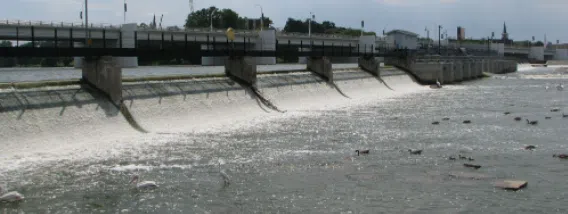GREEN BAY, WI (WTAQ) – In recognition of National Dam Safety Awareness Day, the Wisconsin Department of Natural Resources is reminding Wisconsinites to exercise caution when recreating close to any dams.
Dams are an essential part of the infrastructure in the United States, with over 90,000 dams across the country and nearly 4,000 along Wisconsin’s lakes and rivers.
DNR State Dam Safety Engineer Uriah Monday says the easiest way to stay safe is to simply observe your surroundings.
“Pay attention to the signs, pay attention to fences, pay attention to buoys – all of those things,” Monday told WTAQ News. “Know your route. A lot of small craft users will scout their route ahead of time. That’s a big key…Become familiar with the area you’re in. Ask questions [to DNR officials].”
If you find yourself drifting towards a dam, Monday says to stay calm.
“If you find yourself unawares and with danger upon you, don’t panic. Get the shore, get anywhere safer than the dam, that’s a good plan,” Monday said. “Dams come in all shapes and sizes. We have real big ones that are obvious to the public, and sometimes those are the least dangerous because they are the most obvious…Smaller dams on some of the smaller dams aren’t as high, aren’t as dramatic, but can still pose a risk.”
Outdoor enthusiasts can stay safe near dams by following these safety tips:
- Obey all warning signs, barriers and flashing lights, horns and sirens
- Wear a life jacket
- Always stay outside buoy lines and away from restricted areas near dams
- Never swim or wade near a dam
- Never boat or fish alone when near a dam
- Leave your boat motor running to provide maneuvering power
- Stay clear of spillways – changing currents and “boiling” waves can make boat control difficult near dams
- Be aware that reverse currents occur below dams and can pull a boat back toward the dam into the spillway and capsize it
- Never anchor boats below a dam as water levels can change rapidly
- Set an example for children who may not be aware of the dangers
- If dams fail, flooding can be destructive. The Wisconsin DNR Dam Safety Team provides technical assistance to dam owners in Wisconsin, including inspections, risk identification, emergency response and review of dam repair plans.
Dams in Wisconsin may be owned by private individuals, municipalities, lake districts or federal agencies. The DNR owns about 300, most of which were created to generate recreational opportunities like fishing, hunting and boating. When recreating around a dam, it is important to maintain a safe distance and utilize designated portage areas if one is available.
Many of Wisconsin’s dams were built in the late 1800s and early 1900s. Over time, water pressure and weathering will slowly break down a dam. If left unmaintained, dams pose an increased risk to life and property making problems such as sudden breaks more likely during flood conditions.
In 1889, dam safety gained national attention when the failure of the South Fork Dam near Johnstown, Pennsylvania, claimed more than 2,200 lives resulting in the worst dam failure in U.S. history. National Dam Safety Awareness Day commemorates this tragic failure and encourages people to maintain safe, operational dams.
During dam inspections, the most common problems are undesirable woody vegetation on the embankment, deteriorated concrete, inoperable gates and corroded outlet pipes.
The Association of State Dam Safety Officials estimates that the cost to rehabilitate the nation’s non-federal high hazard dams, or those whose failure could cause loss of life, exceeds $24 billion. Rehabilitation is an integral part of maintaining or improving the safety of dams. The DNR provides dam repair and removal grants to assist owners with making their dams safer.
For more information regarding your local risk, your role in dam safety and the benefits and impacts of dams, visit the DNR dam safety webpage.






Comments